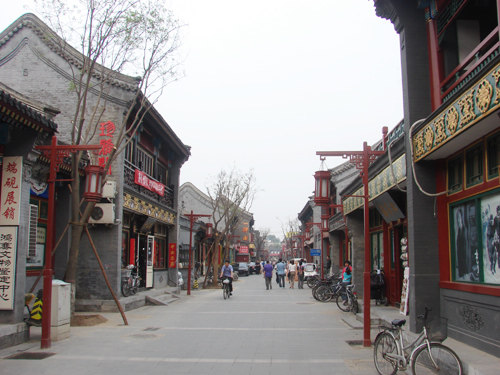|
 |
|
AN OLD STREET: A view of the Liulichang East Street in Beijing, where stores along the street retain traditional style (BAI SHI) |
Outside of the Forbidden City, Beijing's historical districts offer unique scenes of Chinese culture to tourists from around the world. Preserving this cultural heritage is an important task in the rapidly expanding metropolis.
Liulichang (meaning Glass Street in English) stretches 800 meters and boasts a history of over 800 years. Located in the southwest corner of the Second Ring Road near downtown Beijing, it can be dated to the Yuan Dynasty (1271-1368). Residents in that era used kilns to produce colored glaze for the emperors.
By the early Qing Dynasty (1644-1911), the street was home to candidates for the imperial examination held in Beijing every three years. Shops for books, paintings and stationery sprang up to create a dense academic atmosphere. Throughout centuries of development, Liulichang has become Beijing's iconic cultural and commercial street. Famous stores such as Rongbaozhai sell traditional Chinese artwork, including ink brushes, inkstands, the rice paper, antiques and paintings.
Hu Jinzhao, a nearly 80-year-old resident of Liulichang, is an amateur researcher of its history. Hu describes the area with a sense of pride. "When I was a child, I remember that all culture-related goods could be found along the street," he recalled. "At that time, Liulichang was an inclusive and prosperous street for both traditional and new cultures."
After its decline during the War of Resistance Against Japan (1937-45), Liulichang soon recovered following the founding of the People's Republic of China in 1949. Many foreign celebrities and scholars, such as the British sinologist Dr. Joseph Needham, visited the street during their tours of Beijing.
However, the "cultural revolution" (1966-76) dealt a severe blow to Liulichang. Hu still recalls the period with sadness. "Most of the goods sold in Liulichang were destroyed by people as the 'four olds'," he said, referring to the old ideas, old culture, old customs and old habits to be eliminated. "Antique shops and book stores were shut down and turned into variety stores. The whole street went through a long period of depression," Hu added.
In 1980, former Vice Premier Gu Mu proposed to restore Liulichang. Thereafter, the street was reconstructed and again opened to people four years later. Even with repairs, Liulichang did not completely recover its original sense of culture and history.
"Renovation is necessary," Hu said. "Though many old stores and architectures got more spacious and beautiful, the simplicity and cultural connotation of the street have gotten lost," Hu said.
Despite criticism of the new architecture, Liulichang has retained its major function in the city of fostering traditional culture.
Today, it seems that many Beijing residents are unaware of the existence of Liulichang. Hu admitted that new generations of Chinese people are less interested in traditional culture, and are instead drawn to modern education and new technologies. Only some tourists and enthusiasts of Chinese traditions are frequent visitors to Liulichang. The previously bustling scenes in Hu's childhood can hardly be imagined today.
In order to preserve and promote the traditional cultural heritage, the Beijing Municipal Government made plans in 2008 to establish a creative industry park in Liulichang.
Hu sees a promising future for the ancient street in recent blueprints. But Liulichang must follow its tradition in development, he stressed.
"The new plan should focus on preserving and promoting the functions of Liulichang rather than constructing a modern and high-rise building," said Hu.
The role of Liulichang has changed through its history, from an ancient haven for artists and academics, to a center of tourism for books and antique stores at present, and to a creative industry park in the near future. No matter what difficulty it meets, Liulichang will always be a window into the enchanting Chinese culture.
Email us at: baishi@bjreview.com | 